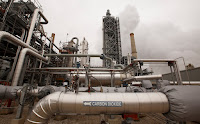Can one of the most promising — and troubled — technologies for fighting global warming survive during the administration of Donald J. Trump?
The technology, carbon capture, involves pulling carbon dioxide out of smokestacks and industrial processes before the climate-altering gas can make its way into the atmosphere. Mr. Trump’s denial of the overwhelming scientific evidence supporting climate change, a view shared by many of his cabinet nominees, might appear to doom any such environmental initiatives.
But the new Petra Nova plant about to start running here, about 30 miles southwest of Houston, is a bright spot for the technology’s supporters. It is being completed essentially on time and within its budget, unlike many previous such projects. When it fires up, the plant, which is attached to one of the power company NRG’s hulking coal-burning units, will draw 90 percent of the CO2 from the emissions produced by 240 megawatts of generated power. That is a fraction of the roughly 3,700 megawatts produced at this gargantuan plant, the largest in the Lone Star State. Still, it is enough to capture 1.6 million tons of carbon dioxide each year — equivalent to the greenhouse gas produced by driving 3.5 million miles, or the CO2 from generating electricity for 214,338 homes.
...
Petra Nova uses the most common technology for carbon capture. The exhaust stream, pushed down a snaking conduit to the Petra Nova equipment, is exposed to a solution of chemicals known as amines, which bond with the carbon dioxide. That solution is pumped to a regenerator, or stripper, which heats the amine and releases the CO2.
Petra Nova, a billion-dollar joint venture of NRG and JX Nippon Oil and Gas Exploration, will not just grab the CO2, it will use it, pushing compressed CO2 through a new pipeline 81 miles to an oil field. The gas will be injected into wells, a technique known as enhanced oil recovery, that should increase production to 15,000 barrels a day from about 300 barrels a day. And since NRG owns a quarter of the oil recovery project, what comes out of the ground will help pay for the carbon capture operation.
The plant, which has received $190 million from the federal government, can be economically viable if the price of oil is about $50 a barrel, said David Knox, an NRG spokesman. The company expects to declare the plant operational in January, Mr. Knox said. Aware of problems with carbon capture projects around the country and of the risks of hubris, he said: “We’re not going to declare victory before it’s time.”
If the price of oil stabilizes or rises, and if tax breaks for developing the technology continue and markets for carbon storage develop, he said, utilities might ask, “why would I not want to put a carbon capture system on my plant?”
...
Carbon capture systems are not just expensive to build; they tend to be power-hungry, and make the plant less efficient over all — a problem known as “parasitic load.” The Petra Nova carbon capture process gets its energy from a separate power plant constructed for the purpose, which NRG says makes the system more efficient than it would otherwise be, and frees up all of the capacity of the main power plant to sell all of the electricity it produces. The company estimates that the next plant it builds could cost 20 percent less, thanks to lessons learned this time around.
...
If Petra Nova succeeds, it means a boost for carbon capture. Despite carbon capture’s problems, its supporters, including the Intergovernmental Panel on Climate Change and the International Energy Agency, call the technology, known as carbon capture sequestration, crucial for meeting emissions standards that can prevent the worst effects of climate change.
...
One of the most innovative approaches to carbon capture is being tried 50 miles east of the Petra Nova plant, in La Porte, Tex., where a consortium of companies is trying an entirely new approach to low-carbon power generation.
In a $140 million, 50 megawatt demonstration project, the company, Net Power, will use superheated carbon dioxide in much the same way that conventional power plants use steam to drive turbines. This system, invented by a British engineer, Rodney Allam, eliminates the inefficiency inherent in heating water into steam and cooling it again. The power plant produces a stream of very pure, pressurized carbon dioxide that is ready for pipelines without much of the additional processing that conventional carbon capture systems require.
Read more at Can Carbon Capture Technology Prosper Under Trump?

No comments:
Post a Comment